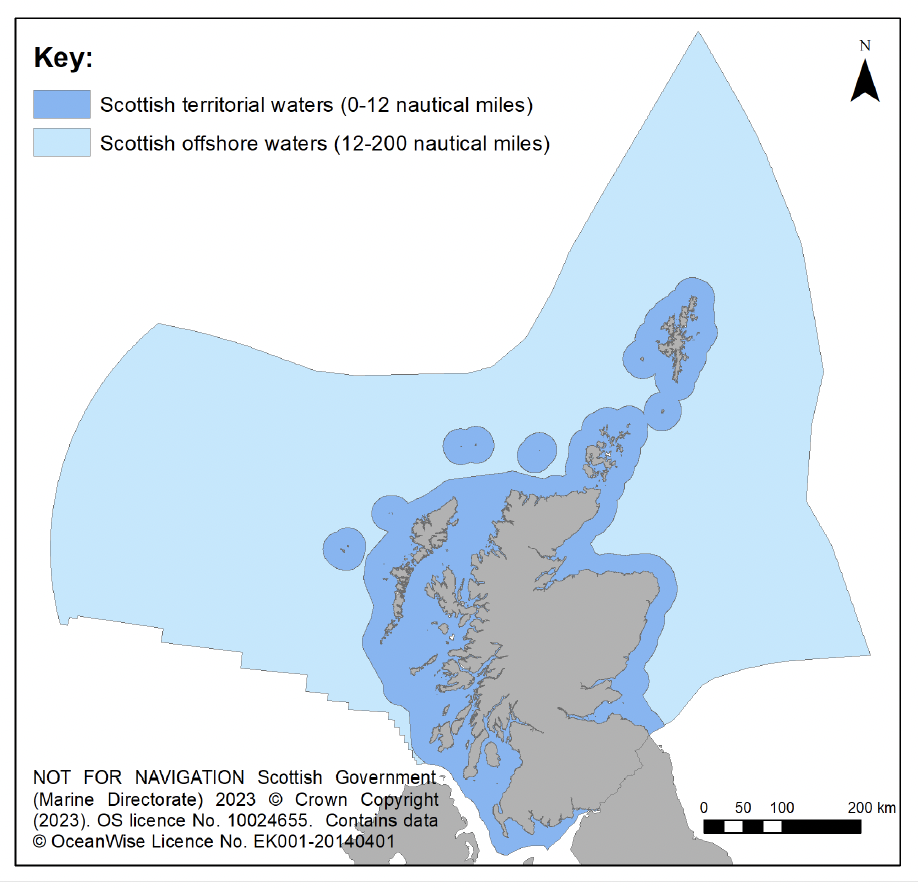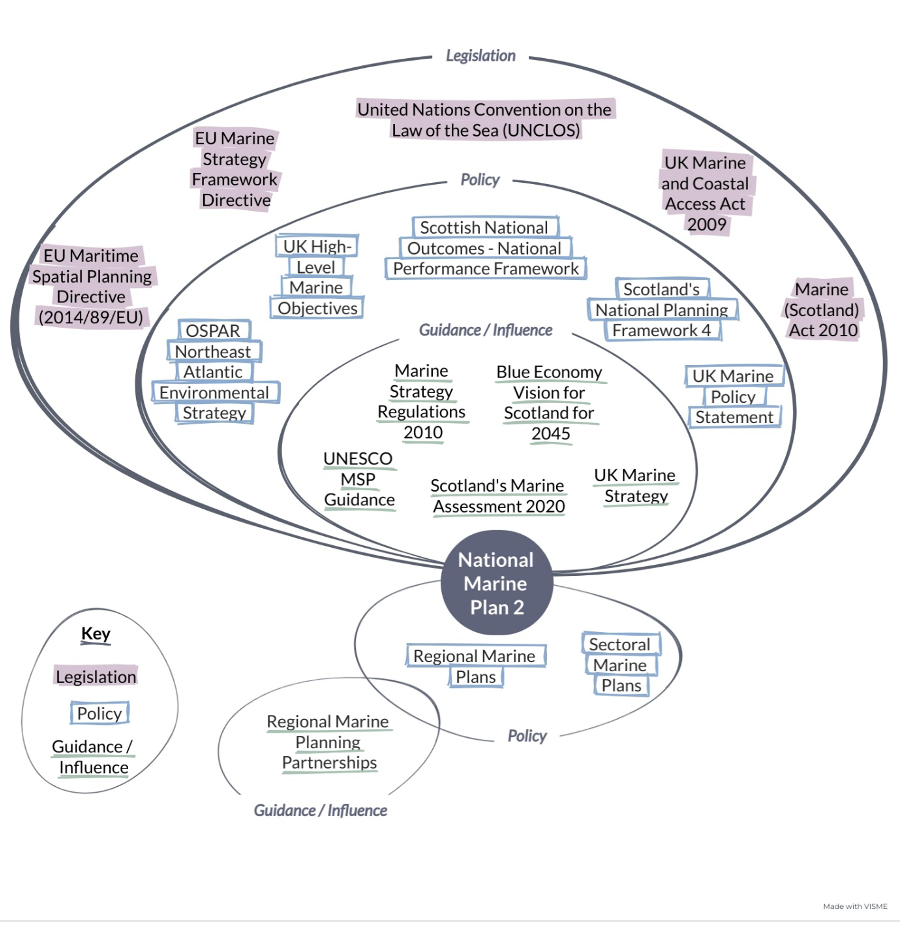National Marine Plan 2 - strategic environmental assessment: scoping report
Sets out the proposed scope and level of detail for the strategic environmental assessment (SEA) of National Marine Plan 2 (NMP2), along with a description of the proposed assessment methodology.
1. Introduction
Background
1.1. Scottish Ministers are required under the Marine (Scotland) Act 2010 to prepare and adopt a national marine plan for the Scottish marine area. In accordance with this requirement, Scotland’s National Marine Plan (NMP) was published in 2015. Scottish Ministers are required, under Part 3 of the 2010 Act to keep the plan under review. Since its adoption in 2015, the current National Marine Plan has been reviewed twice, in 2018 and 2021, in line with statutory requirements. The statutory reviews concluded that there is an urgent need to tackle the twin crises of climate change and biodiversity loss, as well as a need to reflect significant emerging matters, which have become core drivers for developing a new national marine plan.
1.2. The decision to update and replace the existing National Marine Plan was formally announced by Ministers in Parliament in October 2022 and in the Programme for Government 2022-23. Marine Directorate are currently preparing the updated National Marine Plan 2, also referred to as ‘the plan’ or ‘NMP2’ in this report. As with the first National Marine Plan, NMP2 will cover Scottish territorial waters (0-12 nautical miles) and Scottish offshore waters (12-200 nautical miles) (Figure 1).

1.3. The implementation of National Marine Plan 2 has the potential to have significant environmental effects. A Strategic Environmental Assessment (SEA) will therefore be required under the Environmental Assessment (Scotland) Act 2005 and the Environmental Assessment of Plans and Programmes Regulations 2004.
1.4. As NMP2 falls under Section 5(3) of the 2005 Act and under part 5(2) of the 2004 Regulations, the SEA will proceed directly to scoping.
1.5. The Marine and Coastal Access Act 2009 requires Marine Directorate, as the Responsible Authority, to carry out an appraisal of the sustainability of NMP2 (Schedule 6 S.10(1)). The SEA forms part of the wider Sustainability Appraisal (SA), along with the Habitat Regulations Appraisal (HRA) and the Socio-Economic Impact Assessment (SEIA).[1] The SA process, encompassing the findings of the SEA, HRA, and SEIA will be undertaken by appointed contractors.
1.6. The purpose of scoping is to identify the environmental topics to be taken into consideration during the SEA and, thus, to set the scope of the environmental assessment. It will also identify the assessment methods to be used and to confirm the proposed consultation period for the draft NMP2 and Environmental Report. This report sets out the findings of the scoping process undertaken for the plan. The views of the Scottish Consultation Authorities (CAs), the UK Consultation Bodies, and interested parties on the scoping report are now being sought.
Report Structure
1.7. This report includes the following sections:
- Section 1 introduces the plan, including its broad legislative and policy context, and provides a description of the plan.
- Section 2 defines the context for the SEA, including an overview of relevant environmental protection objectives and a broad environmental baseline related to the plan.
- Section 3 sets out the approach to the assessment of the plan.
- Section 4 provides details of the next steps in both the SEA and plan preparation, including proposed timescales for consultation.
Legislative and Policy Context for Plan Preparation
1.8. National Marine Plan 2 is being prepared in the context of international, European, United Kingdom (UK) and Scottish marine legislation, policy, and guidance (Figure 2).
Figure 2. The broad context of National Marine Plan 2 at the international, EU, UK, and Scottish levels, including legislation (pink, top outer circle), policy (blue, top middle circle), and guiding and influencing factors (green, top inner circle). There exist inter-connections between many of the elements highlighted in the figure. NMP2 will continue to provide the context for the Regional and Sectoral marine planning processes, which allow for more localised and spatial considerations.

1.9. At the international level, the United Nations Convention of the Law of the Sea established the right of coastal nations to set laws and regulate the use of the marine area out to 12 nautical miles. The Convention also establishes exclusive economic zones from 12 to 200 nautical miles from the coast, within which the coastal nation has sole rights over all natural resources. The OSPAR convention for the Protection of the Marine Environment of the North-East Atlantic regulates international cooperation on environmental protection in the North-East Atlantic. The OSPAR convention combined and updated the 1972 Oslo and 1974 Paris Conventions to extend the cooperation of the Contracting Parties to cover all human activities that might adversely affect the marine environment of the North-East Atlantic.
1.10. At the European level, the European Union (EU) Marine Strategy Framework Directive (Directive 2008/56/EC) aims to protect more effectively the marine environment across Europe, achieve Good Environmental Status (GES) of the marine environment, and protect the resource base upon which marine-related economic and social activities depend. The UK’s regional cooperation under the Directive takes place through the existing framework of the OSPAR convention. The Directive is transposed in UK legislation by the Marine Strategy Regulations 2010 and, following the UK’s departure from the EU, the UK reports progress towards GES through its Marine Strategy.
1.11. The National Marine Plan enacts principles of EU Directive 2014/89/EU on maritime spatial planning, which establishes a framework for maritime spatial planning aimed at promoting the sustainable growth of maritime economies, the sustainable development of marine areas and the sustainable use of marine resources. As the UK is no longer a member of the EU, EU legislation, as it applied to the UK on 31 December 2020, is now a part of UK domestic legislation as set out in the EU (Withdrawal) Act 2018.
1.12. At the UK level, the Marine and Coastal Access Act 2009 requires that marine plans are prepared for the UK marine area (0 to 200 nautical miles). The devolved administrations (the Scottish Government, the Welsh Assembly Government, and the Northern Ireland Executive) have jurisdiction over marine planning matters in their respective waters from 0 to 12 nautical miles (inshore waters). For the purposes of marine planning, the marine area from 12 to 200 nautical miles (offshore waters) is executively devolved to the Scottish Ministers.
1.13. In accordance with this legislation, the UK Government and devolved administrations prepared a joint Marine Policy Statement (MPS). The MPS provides the framework for preparing marine plans and taking decisions related to the marine environment, and the Marine and Coastal Access Act 2009 requires that Marine Plans must be in conformity with the MPS. The MPS outlines the UK vision for ‘clean, healthy, safe, productive and biologically diverse oceans and seas’. It sets out the ‘High Level Objectives’ for the marine environment, along with policy objectives for key activities that take place in the marine environment that were agreed amongst the four UK administrations to fulfil this vision.
1.14. In Scotland, the legislative and management framework for the marine environment is established by the Marine (Scotland) Act 2010. The National Marine Plan for Scotland, adopted in 2015, reflects the legislative provisions outlined in both the Marine (Scotland) Act 2010 and the Marine and Coastal Access Act 2009, providing a cohesive approach to the management of both inshore and offshore waters.
1.15. The Marine (Scotland) Act 2010 provided for the development of Regional Marine Plans in 11 marine regions in Scottish waters out to 12 nautical miles, as set out in the Scottish Marine Regions Order 2015. The Regional Plans will be directed by the objectives and policies of the National Marine Plan, developed by regional Marine Planning Partnerships, and can better reflect local circumstances and priorities. The landward extent of each of the marine regions is defined the Scottish Marine Regions Order 2015.
1.16. To facilitate the sustainable development of offshore renewable energy in Scottish waters, through the Renewables 1 policy in Scotland’s National Marine Plan (2015), the Scottish Government has introduced a system of sectoral marine planning. Any regional and sectoral marine plans that are developed are subject to their own plan-level assessments, including SEA.
1.17. National Planning Framework 4 (NPF4) is Scotland’s national spatial strategy for terrestrial planning and the development and use of land. It sets out Scottish spatial principles, regional priorities, national developments, and national planning policy. NPF4 includes national planning policy related to coastal areas and aquaculture, and alignment between NPF4 and NMP2 is key.
1.18. The Bute House Agreement, a shared policy programme between the Scottish Government and Scottish Green Party Parliamentary Group, includes commitments to enhance marine environmental protection and strengthen the framework of support for the marine renewables and offshore wind sectors.
1.19. There are a significant number of policy and legislative drivers at national, UK-wide, European, and global levels that apply to the various users of the marine environment (including transport, fishing, shipping, energy, and renewables). These requirements will be taken into account throughout the development of the draft Plan.
1.20. Scotland’s Marine Assessment 2020 (SMA2020) provides an assessment of both the state of Scotland’s seas and of the main activities and pressures, and it will provide the broad evidence base for development of NMP2. It will provide environmental information for the baseline against which the plan will be both developed and environmentally assessed. Where required, additional and updated baseline information will be taken into account as part of the environmental baseline.
1.21. The Blue Economy Vision sets out the Scottish Government’s long-term ambition for Scotland’s Blue Economy to 2045 and provides an overarching framing for Scotland’s marine policies, plans and decisions. It promotes an approach that is consistent with Scotland’s National Performance Framework and our international obligations. The Vision sets out six long-term Blue Economy outcomes across environmental, economic, and social benefits for our marine environment, for people and our economy. The outcomes describe our high-level ambition for transformative change in the way we see and use our oceans. NMP2 will adopt a blue economy approach and act as a key delivery mechanism for Scotland’s Blue Economy Vision.
Description of the Plan
1.22. NMP2 will continue to provide the guiding planning framework, that has been initiated by the first National Marine Plan, for sustainable development and management of use of our seas.
1.23. The new NMP2 will adopt a Blue Economy approach. It will help to get the right framework in place to address the increasing competition for marine space and resources, and that acknowledges the variety of demands and needs for and from the marine environment and continue to support licencing and consenting decisions.
1.24. The plan area covers Scottish territorial and offshore waters, extending from Mean High Water Spring (MHWS) tide to 200 nautical miles, with the landward extent of the Scottish Marine Regions defined in the Scottish Marine Regions Order 2015. As with the existing National Marine Plan, NMP2 will include provisions for reserved functions such as oil and gas, shipping and telecommunications, for which Scottish Ministers have planning responsibility, however licensing of these matters will remain reserved to UK Ministers. In accordance with the Marine Acts, National Marine Plan 2 will be reviewed every 3 and 5 years and updated as required.
1.25. NMP2 will therefore contain:
- The vision for the plan, set out in Marine Directorate’s marine vision[2] and agreed at the UK level
- High-level objectives for the plan, in alignment with Scottish Government ambitions and commitments, UK High-Level Objectives, and international commitments such as objectives set out in OSPAR’s North-East Atlantic Environment Strategy 2030 or the criteria for good environmental status under the Marine Strategy Framework Directive
- Sector- or region- specific objectives and policies
1.26. NMP2 will continue to provide the overarching framework for the sectoral marine planning process and the context for Regional Marine Plans in Scotland.
Contact
There is a problem
Thanks for your feedback